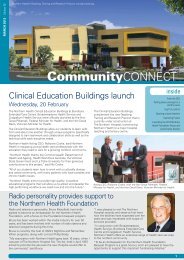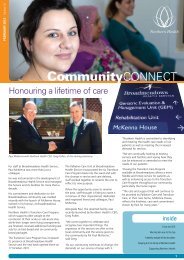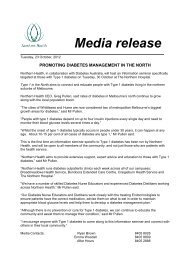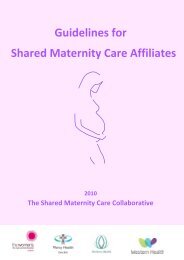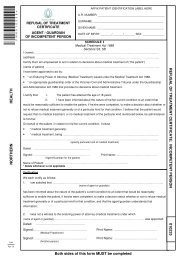Research Week Abstract Book - Northern Health
Research Week Abstract Book - Northern Health
Research Week Abstract Book - Northern Health
Create successful ePaper yourself
Turn your PDF publications into a flip-book with our unique Google optimized e-Paper software.
<strong>Health</strong> Service Evaluation<br />
EFFECTS OF HOSPITAL ACQuireD CONDITIONS ON LENGTH OF STay FOR<br />
DiabeTIC PATIENTS<br />
Cromarty J, Parikh S, Lim WK, Jackson TJ.<br />
Background<br />
Inpatients with diabetes are known to have longer lengths of stay (LOS) when hospitalized. Understanding differences in<br />
the rates and patterns of hospital acquired conditions between diabetes and similarly-complex patient sub-populations may<br />
reveal preventative measures to improve patient welfare and minimise length of stay.<br />
Aim<br />
To evaluate the rate of hospital acquired conditions amongst diabetic and non-diabetic patients, to characterise differences in<br />
the type of complications these patients are most at risk of developing, and any effects on length of stay.<br />
Methodology<br />
47615 admission episodes from The <strong>Northern</strong> Hospital database (1 July 2011 to 30 June 2012) were reviewed in this<br />
study. These episodes were divided into four groups: 1) patients with no recorded diabetes (n=45299), 2) patients with a<br />
diagnosis of diabetes without end-organ complications (n=356), 3) patients with a diagnosis of diabetes with end-organ<br />
complications (n=1775), and 4) a subset of Group 1 non-diabetic patients with a Charlson co-morbidity score ≥1 (n=9255).<br />
Hospital acquired conditions were defined using the Classification of Hospital Acquired Diagnoses (CHADx). Linear<br />
regression was used to analyse the impact of group membership and the number of CHADx, on length of stay.<br />
Results<br />
Almost 30% of all admissions of diabetic patients with end-organ complications had at least one hospital acquired condition,<br />
compared to only 13% for all non-diabetic patients and 17.6% for the subgroup of non-diabetic patients with a Charlson comorbidity<br />
score ≥1. While the types of hospital-acquired conditions in diabetic patients with end-organ complications were<br />
similar to their non-diabetic counterparts, their rates were consistently higher than the rates of similarly complex non-diabetic<br />
patients. The younger non-diabetes and diabetes with no end-organ complications groups had intermediate rates of these<br />
conditions. Linear regression demonstrated that diabetes patients with end-organ damage stay longer than other patients,<br />
and that each complication in a diabetes episode has a larger effect on LOS.<br />
Conclusion<br />
We demonstrate that increased infection rates and delayed wound healing are not the only conditions leading to excess<br />
length of stay. These findings may provide a foundation for future clinical and cost-effectiveness studies of preventative<br />
practices for this high-risk patient population<br />
46<br />
<strong>Research</strong> <strong>Week</strong> <strong>Abstract</strong> <strong>Book</strong> <strong>Northern</strong> <strong>Health</strong> 2013



